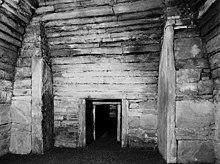Maeshowe



Maeshowe, also known as Orkhaugr, a burial mound in Orkney, Scotland, with underground passage graves.[1] It was built during the Neolithic period, about 3000 years ago. It has been included in the World Heritage Site, Heart of Neolithic Orkney.
The mound used to be taller, with a depression in the top, looking like a small volcano. It measured 11 meters in height and had a diameter of 30 meters.[2] This was changed in 1861 when the mound was dug into by archaeologist James Farrer.
It was built on a raised level area and surrounded by a ditch and a raised bank. It may have been built on top of an earlier structure. Research shows that the ditch used to be filled with water, and there was a large stone circle around the mound. The grave itself is a long narrow entrance opening into a large chamber. There are three smaller rooms which open into the main chamber.[2] It has been built to line up with the sun at the Winter Solstice.[1]
Maeshowe had been dug up in the 12th century by the Vikings.[2] It has many Norse carvings on the rocks.
References[change | change source]
- ↑ 1.0 1.1 "Documents in Maeshowe - Academia.edu". Retrieved 2012-12-11.
- ↑ 2.0 2.1 2.2 "Maeshowe, Orkney's finest chambered cairn". Orkneyjar: Heritage of the Orkney Islands. Orkneyjar. 2012. Retrieved December 11, 2012.
